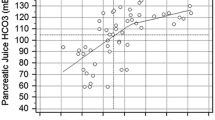Abstract
Background: Because some investigators have reported the systematic occurrence of exocrine pancreatic insufficiency after pancreaticoduodenectomy with pancreaticogastric anastomosis (PGA), we assessed PGA patency after pancreaticoduodenectomy.
Methods: Nineteen patients underwent pancreaticoduodenectomy, and their PGAs were studied prospectively with secretin magnetic resonance cholangiopancreatography (MRCP). After administration of negative bowel contrast agent, single-shot fast spin-echo T2-weighted dynamic MR pancreatograms were obtained before and every minute for 12 min after secretin injection. Morphologic features of the pancreatic parenchymal and pancreatic duct were monitored (diameter and winding aspect of the pancreatic duct, pancreatic thickness, direct visualization of the anastomotic site). PGA permeability was classified into four grades, from 0 (obstruction) to 3 (good permeability). Pancreatic function was assessed by fecal-1 elastase concentration, fasting blood glucose, and fasting serum insulin level.
Results: MRCP grades were 0 in two patients, 1 in four, 2 in five, and 3 in eight. The anastomotic site was visualized in 10 patients. Pancreatic parenchymal atrophy was discovered in four patients. There were statistically significant relations between secretin MRCP permeability grade and fecal-1 elastase concentration (p < 0.03) and between secretin MRCP permeability grade and pancreatic atrophy (p < 0.005). In contrast, fecal-1 elastase concentration was lower than the normal value in all but one case. There was no statistically significant relation between fecal-1 elastase concentration and other morphologic data.
Conclusion: Secretin MRCP may indicate PGA stenosis or dysfunction, but it is not the only factor suggesting exocrine pancreatic insufficiency. Thus the major role of PGA may be the preservation of long-term endocrine function.
Similar content being viewed by others
Author information
Authors and Affiliations
Rights and permissions
About this article
Cite this article
Aubé, C., Lebigot, J., Pessaux, P. et al. Evaluation of the permeability of pancreaticogastric anastomoses (PGA) with dynamic magnetic resonance pancreatography after secretin stimulation (secretin MRCP). Abdom Imaging 28, 0563–0570 (2003). https://doi.org/10.1007/s00261-002-0065-8
Published:
Issue Date:
DOI: https://doi.org/10.1007/s00261-002-0065-8




